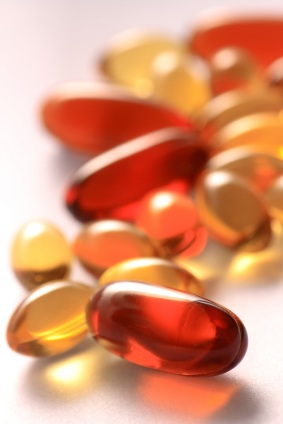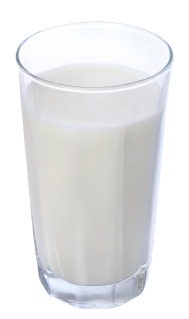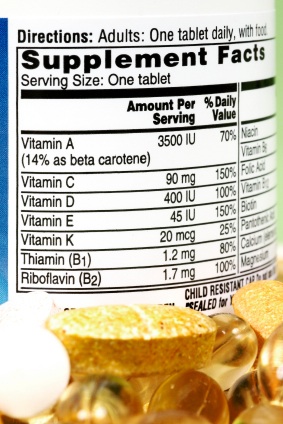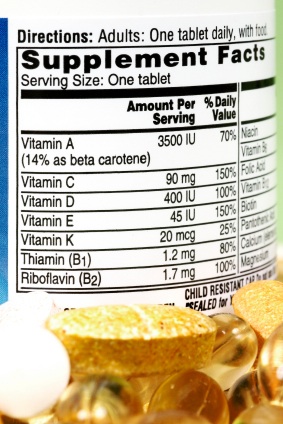Naphthoquinone is a fat-soluble vitamin. It is an organic compound that has the formula C10H6O2. It can be viewed as derivatives of naphthalene through the replacement of two hydrogen atoms by two ketone groups. It is a yellow crystalline substance that is related to quinone, procurable by oxidizing naphthalene with chromic acid.
Naphthoquinone has an odor similar to benzoquinone. It is slightly soluble in cold water and petroleum ether. It is soluble in most polar organic solvents. Naphthoquinone derivatives possess anti-bacterial and anti-tumor properties. 1,4-naphthoquinone derivatives occur naturally in the form of vitamin K.
Vitamin K Overview
 The “K” in vitamin K comes from the German work “koagulation.” Coagulation refers to the process of blood clotting. Vitamin K is a group of vitamins (K1, K2, and K3) which promote clotting of the blood. They are a class of compounds that contain the naphthoquinone structure. Vitamin K regulates normal blood clotting and prevents hemorrhaging.
The “K” in vitamin K comes from the German work “koagulation.” Coagulation refers to the process of blood clotting. Vitamin K is a group of vitamins (K1, K2, and K3) which promote clotting of the blood. They are a class of compounds that contain the naphthoquinone structure. Vitamin K regulates normal blood clotting and prevents hemorrhaging.
The anti-hemorrhagic factor in vitamin K and its synthetic analogues have a specific effect on prothrombin deficiency.
Vitamin K increases the synthesis of prothrombin, which is a blood-clotting protein, by the liver.
It helps prevent calcification in the arteries and it may also help to reduce the risk of bone injuries and fractures.
Types of Vitamin K
There are two types of vitamin K found in nature. Vitamin K1 or phytonadione is found in plants, and vitamin K2 or menaquinone can be synthesized by multiple bacteria. Vitamin K3 or menadione is not considered to be a natural vitamin K.
The group of vitamin K vitamins have a methylated naphthoquinone ring structure. The naphthoquinone is the functional group, which makes the structure of action similar in all K-vitamins. The lipophilicity of the various side chains and the different food matrices in which they occur cause the differences in each of the vitamins.
Vitamin K1
Vitamin K1 is a form of vitamin K. It has the chemical name 2-methyl-3phytyl-1, 4-naphthoquinone. It’s compound formula is C31,H46,O2. It is a clear, yellow to amber, viscous liquid that is odorless or almost odorless. It is one of the oil-soluble vitamins found in green plants and prepared synthetically. It is soluble in chloroform, but insoluble in water. It is used as a prothrombinogenic agent. Vitamin K1 was named phylloquinone because it is an indirect product of photosynthesis in plant leaves.

Vitamin K1 is found in green vegetables such as spinach, broccoli, avocado, brussel sprouts, kale and cabbage, cauliflower, kiwi, alfalfa and some vegetable oils, or it can be made synthetically. It can be given orally to treat prothrombin deficiency that may result from anticoagulant drugs.
Vitamin K2
Vitamin K2, also known as menaquinone, has the chemical name 2-methyl-3-difarnesyl-1, 4-naphthoquinone. It’s compound formula is C41H56O2. It is a naturally occurring vitamin that is found in various large intestine bacteria. Vitamin K2 helps activate vitamin K dependent proteins responsible for healthy tissue and bone. It helps to activate the protein, osteocalcin, which is required to bind calcuim to the mineral matix, which strengthens the bones. It is found in sources such as butter, eggs, cow liver, cheese and fermented products.
Vitamin K3
Vitamin K3 is also known as menadione. It has the chemical name 2-methyl-1, 4 naphthoquinone. It’s compound formula is C11H8O2. It is a bright yellow crystalline powder that is soluble in vegetable oils. It is a synthetic analogue that acts as a provitamin. It is used as a vitamin K supplement. Menadione is necessary for the production of prothrombin and other blood clotting factors. It can also help regulate the calcification of bones. Too large a dose of vitamin K3 can cause serious problems, and even death.
Vitamin K Deficiency
Vitamin K and all other liposoluble vitamins are stored in the fat tissue of the human body. A vitamin K deficiency in healthy adults is not common, however, there is an increased risk of a deficiency in newborn infants. Also, infants who are breast-fed are at a higher risk for a vitamin K deficiency.
Adults who take anticoagulant drugs or individuals who have liver damage or disease are at a higher risk of vitamin K deficiency. Individuals who suffer from cystic fibrosis, inflammatory bowel diseases or have had recent abdominal surgeries may be at a higher risk for deficiency. Individuals who have a problem with intestinal absorption of fats may also be at an increased risk of vitamin K deficiency.
Drugs Causing Deficiencies
Individuals who have strict diets or have eating disorders, such as anorexia or bulimia, may suffer from secondary vitamin K deficiency. Some drugs also interfere with vitamin K deficiency such as salicylates, barbiturates, and cefamandole.
Vitamin A and vitamin E have been shown to interfere with vitamin K if they are taken in large doses. Vitamin A may effect the absorption of vitamin K and vitamin E can inhibit vitamin K dependent carboxylase enzymes.
There are no differences in the causes of deficiency of vitamin K between men and women.
Symptoms of Vitamin K Deficiency
Some of the symptoms of a vitamin K deficiency in the body include bleeding and bruising easily, gastrointestinal bleeding, nose bleeds, bleeding gums, the presence of blood in the urine, blood in the stool, tarry black stools, and abnormally long or heavy menstruation in women.
Vitamin K deficiency in infants may result in a bleeding disorder, vitamin K deficiency bleeding (VKDB), that is life-threatening, but easily preventable. Because VKDB is preventable, the American Academy of Pediatrics recommend that an injection of vitamin K1 or phylloquinone be given to all newborn babies. Human milk is low in vitamin K, however, baby formula tends to be much higher in the content of vitamin K.
Dosage Recommendations
Because of the occurrences of vitamin K deficiency bleeding in newborn infants, the Committee on Nutrition of the American Academy of Pediatrics recommends that 0.5 to 1.0 mg of vitamin K be administered to newborns once they are born.
The Food and Nutrition Board of the Institute of Medicine recommends the following dosages for children:
- Children ages 1-3 years of age should have 30mcg/day
- Children ages 4-8 years of age should have 55mcg/day
- Children ages 9-13 years of age should have 60mcg/day
- Children ages 14-18 years of age should have 75mcg/day
The Food and Nutrition Board of the Institute of Medicine recommends the following dosages for adults:
- Adult males 19 years and older should have 120 mcg/day.
- Females 19 years and older should have 90 mcg/day.
- A woman 19 years and older that is pregnant or breastfeeding should have 90 mcg/day.
- A woman 18 years and younger that is pregnant or breastfeeding should take 75 mcg/day.
Toxicity
There is no known toxicity associated with high doses of vitamin K1 or vitamin K2. However, vitamin K3, a synthetic form of vitamin K, has been proven to be toxic. It can interfere with the function of glutathione, one of the body’s natural antioxidants. The FDA has banned menadione, or vitamin K3, from over-the-counter supplements because large doses can cause allergic reactions, induce liver toxicity, jaundice and hemolytic anemia.
Vitamin K Sources
Vitamin K is found in many food sources. Vitamin K sources include leafy green vegetables such as:
- Lettuce
- Broccoli
- Brussel sprouts
- Cabbage
- Collard greens
- Turnip greens
- Kale
- Parsley
- Spinach.

Other sources are:
- Soybeans
- Tomatoes
- Egg yolk
- Cauliflower
- Raw watercress
- Olive, Soybean, & Canola Oil
- Beans & Olives
- Cereals
- Dairy products such as milk, cheese, & butter
- Some fruits
- Liver and Pork
Research and Osteoporisis
Studies of vitamin K suggests that it may play a potential role in bone density changes. In Japan, a form of vitamin K2, called menatetrenone, has been used to treat osteoporosis. However, this type of treatment is controversial. The United States is currently conducting their own studies of the relationship between vitamin K2 and bone health.
The latest studies are showing a positive corrolation between vitamin K intake and osteoporosis. People taking Warfarin, an anticoagulant, may need to take extra vitamin K. Warfarin prevents the recycling of vitamin K, which reduces the levels available to the body. This can contribute to weaker bones and increased fractures.
Research and Cardiovascular Disease
New studies are suggesting that vitamin K may play a crucial role in cardiovascular health. Vitamin K2 is needed for activating the protein matrix Gla-protein, which is an inhibitor of vascular calcification. When enough vitamin K2 is present it can help prevent calcium buildup in blood vessels that assist in vascular disease.
Patients who take Warfarin to prevent blood clots that can trigger heart attacks and strokes, may need to supplement with a low dose of vitamin K.
Research and Alzheimers
Research has also shown that vitamin K may reduce neuronal damage and that giving vitamin K supplements to Alzheimer’s patients may have benefits. However, more research is needed to find out the specifics.
Research and Cancer
Scientific evidence and research do not support the use of vitamin K for the prevention or treatment of cancer. A small clinical trial, however, found that a similar vitamin 2 compound may help reduce the recurrence of liver cancer after surgery.
Some studies have suggested that a low vitamin K intake may increase the risk for certain types of cancers. A 2008 published European study found that men with a low intake of some forms of vitamin K are at a higher risk for prostate cancer. A Japan study suggests that vitamin K may lower the risk of developing liver cancer in women who have cirrhosis of the liver.
Potential Benefits
Some alternative medicine practitioners use vitamin K3 as an anticancer supplement, and others claim that taking high doses of Vitamin K3 and Vitamin C may inhibit tumor growth. However, there is not any scientific evidence to support these claims.
Some studies in mice have shown that vitamin K may slow the growth of cancer cells. More clinical studies will need to be done on humans to determine the role in which vitamin K may have on cancer.
Other Uses for Vitamin K
Vitamin K, if applied topically, may help diminish bruising from postoperative procedures, scarring, redness caused by broken blood vessels, rosacea, skin irritations such as burns and sunburns, dark circles under the eyes and aid in the fading of hyper pigmentation.
References & Resources
Applied Therapeutics for Clinical Pharmacists
Dorland’s Illustrated Medical Dictionary
Oregon State University
Usda.Gov
Cancer.Org
Lef.Org















